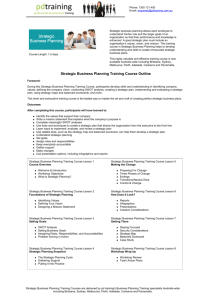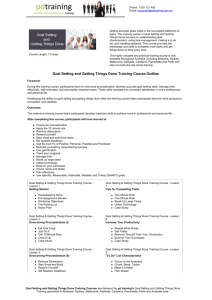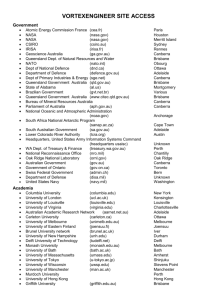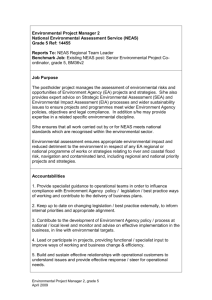elicos national roundtable industry consultation fora (2015)
advertisement
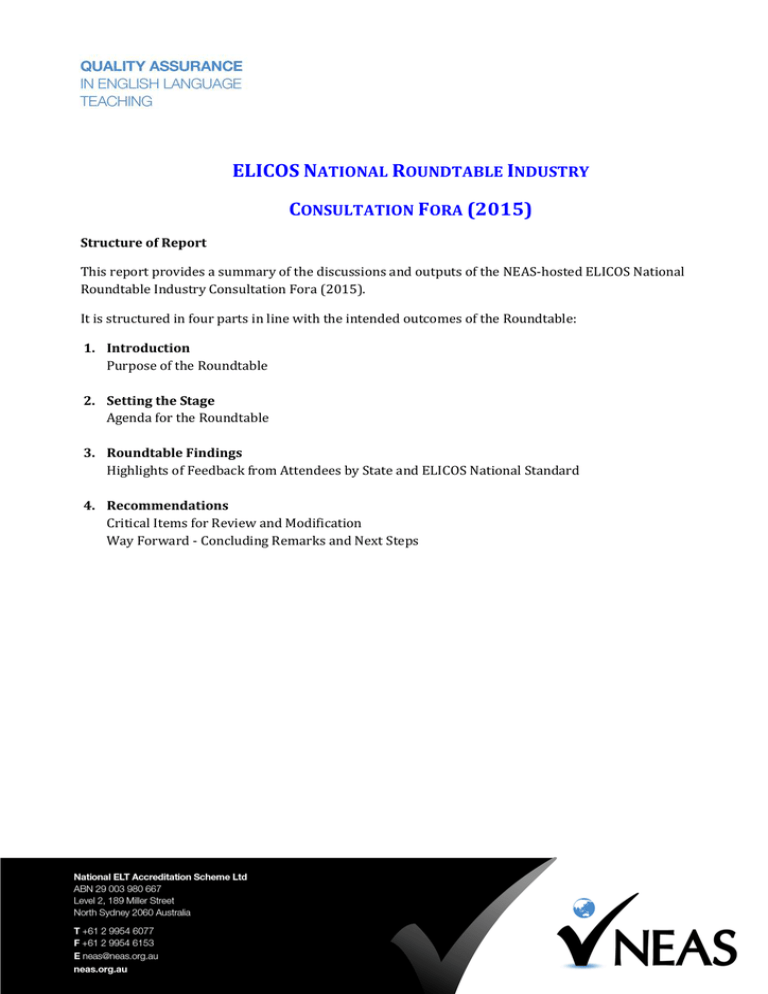
ELICOS NATIONAL ROUNDTABLE INDUSTRY CONSULTATION FORA (2015) Structure of Report This report provides a summary of the discussions and outputs of the NEAS-hosted ELICOS National Roundtable Industry Consultation Fora (2015). It is structured in four parts in line with the intended outcomes of the Roundtable: 1. Introduction Purpose of the Roundtable 2. Setting the Stage Agenda for the Roundtable 3. Roundtable Findings Highlights of Feedback from Attendees by State and ELICOS National Standard 4. Recommendations Critical Items for Review and Modification Way Forward - Concluding Remarks and Next Steps 1. INTRODUCTION The ELICOS National Roundtable Industry Consultation Fora were hosted by NEAS (National ELT Accreditation Scheme) after discussions with the Commonwealth Department of Education’s Policy Branch in Canberra. These discussions resulted in a suggestion that the Government would appreciate hearing the views of Australian ELT providers who had undertaken NEAS Quality Endorsement, with respect to the current status of the ELICOS National Standards (ENS). It is important to note that the compliance with the ENS is a precursor and gateway for ELT providers to be able to engage in the process of continuous quality improvement, via the NEAS Quality Principles. It is through because of this mechanism, that NEAS and its quality endorsed members have a clear and present interest in the matter of changes to the ENS. Participants in the roundtable discussions represented English language teaching centres from Australian universities, TAFE colleges and privately owned global and local ELT providers. Representation of these centres was by Academic Managers and Principal Administrators, as holding the most senior positions in such organisations. The Roundtable had three objectives: 1. Defining whether the ENS requires reforming 2. If so, broadly identifying the elements which need to be reformed 3. Recommending to government the specific elements which should be reformed The Roundtable made use of a mix of methods combining presentations, discussions and group work. A number of documents were prepared in advance of the Roundtable to inform the discussion (see annex 1). Roundtable fora were held in Melbourne, Cairns, Brisbane, Perth, Adelaide and Sydney, with approximately ELT 90 centres represented. NEAS welcomed participants to the Roundtable, underlined it’s strong support for the ENS as the underpinning framework for a stable and well regulated language teaching sector and highlighted the following points: • • • The history of the ELICOS National Standards and NEAS’ role within their formation NEAS’ role in consulting with industry on changes to the ENS How NEAS would report back to the Commonwealth Department and Minister for Education NEAS Chief Executive facilitated a dialogue amongst the representatives. It was underlined that the Roundtable is an opportunity to put words into action and stressed that it was envisaged as a platform for developing new ideas together, forging relationships and facilitating joint planning that can make a real difference on the ground. It was reiterated that the feedback from Roundtable participants would be consolidated into a report and would be circulated to participants for comment, prior to submission to the Commonwealth Government. Page 2 of 21 Page 3 of 21 2. SETTING THE STAGE NEAS ELICOS NATIONAL STANDARDS ROADSHOW Roundtable Agenda 1) NEAS Objectives: • • • • • • 2) ENS History: • • • • Travel to major capital and regional centres to meet with providers Collect industry views on the ELICOS National Standards as they are Collect industry views on changing the ELICOS National Standards Collate data and report to Commonwealth Government Influence policy Report data to industry Origins of the ELICOS National Standards Birth of NEAS / Tiananmen Square Drafting of the first NEAS Quality Standards (1989) Adoption of the ELICOS National Standards in (2007) by Commonwealth Government 3) What we are not discussing today: 4) Discussion: • • • ESOS Act SVP National Code of Practice • • Do we need a change at all? Why? 5) Format of proceedings: • Review the ELICOS National Standards - page by page • Collect notes and bullet points 6) Closing remarks and thank you for the premises: Page 4 of 21 3. ROUNDTABLE FINDINGS A summary of the qualitative feedback received from Roundtable participants has been summarised and consolidated for consideration by industry stakeholders, government representatives and departmental executives. The summary is provided with four main “recommendation” headings, with their intent as follows: Note: YES change: NO change: Definition: Where this heading appears, the report is defining a position as taken by the bulk of respondents. Where this heading appears, the report is confirming that a change to the ENS is required, with a specific mention made of the item(s) that require changing. Where this heading appears, the report is confirming that a change to the ENS is not required. Where this heading appears, the report is confirming that there was some confusion as to the intent or definitions for which the section is responsible, and that clarification is required. The feedback and comments received in relation to each standard are summarised below. Standard C1.1 Note: YES change: Definition: Course Applications It was noted that this standard requires stand-alone integrity, and that the removal of items that might be deemed to be duplicated in other areas of the ENS should not result in their removal from Standard C1.1. The format for items to be included for submission for addition to CRICOS was deemed correct and fit for purpose to protect students (consumers). The only change suggested was that relating to “Maximum Course Fees”, which it was recommended be removed. It was noted that definitions of the following terms were required along with appropriate support documents to increase quality by reducing confusion and expediting compliance: - syllabus curriculum delivery mode Page 5 of 21 Standard P1.1A NO change: YES change: Definition: Concern: Standard P2 YES change: YES change: Concern: Standard P3 NO change: Standard P4: NO change: Concern: Standard P5: NO change: Concern: Contact Hours Contact hours to remain 20 for CRICOS registered courses. More specific standards for the care of young learners were recommended to be drafted by the industry for review and/or adoption. Clarification of terms such as “face-to-face” and “blended learning” to be achieved, alongside their connection to the minimum number of class contact hours required Any erosion of this standard creates options for exploitation and a reduction in quality by unethical providers. Young Learners More specific standards for the care of young learners were recommended to be drafted by the industry for review and/or adoption. A clear requirement for the separation of young learners from adult learners to be effected immediately. The industry noted a clear and present issue relating to the safety of young learners. Teaching Maximum class sizes to remain at 18 in order to be competitive with other countries. Assessment Assessment principles and requirements are robust and fit for purpose. Consistent assessment of learning outcomes to support comparison of proficiency levels between graduates of different centres remains an issue. Standardisation via scales, grades and tests is recommended. Resources The minimum requirements as they are currently presented were deemed sufficient. Influence of “self-paced” and “independent” study resources on “face-to-face” classtime needs defining, i.e.: does the use of these contribute to the 20 hour minimum requirement? Page 6 of 21 Standard P6: NO change: YES change: Standard P7: NO change: Standard P8: YES change: YES change: Definition: Staff Current qualifications for both teachers and Academic Managers or Directors of Study, were noted as being suitable, with no recommendation to increase or decrease the minimum requirements. There was significant recommendation for the inclusion of Applied Linguistics to be included alongside the current TESOL and CELTA teaching qualifications. ELICOS Premises No changes to the current minimum requirements were suggested or recommended. Business Management Recommendation to remove Accounting requirements as these are covered by ASQA and TEQSA. Recommendation that all centres be required to maintain Professional Indemnity insurance. Student records management requirements require clarification. Page 7 of 21 4. RECOMMENDATIONS Critical Items for Review and Modification It can be concluded that the ELICOS National Standards are an important component of the value proposition for consumers of Australian-delivered English language teaching through their support of sound pedagogy and the management of risk. Roundtable participants were generally supportive of the ENS, and expressed the view that the role of the Standards was to protect the reputation of the Australian ELT sector and the rights of its students. They recognised that while the desire for greater flexibility was common, a strong ENS provided a “trade-barrier” against unethical and low quality providers, whose focus was not on the delivery of quality educational learning outcomes. A common remark amongst participants was that an erosion of the ENS would negatively impact on the entire sector. This is largely as minimum attendance hours and maximum sizes are viewed by quality providers as a counter to unethical providers whose primary commercial focus is helping students secure a visa. It was also remarked that for Australia to compete against other ELT study destinations, this jurisdiction requires comparable and competitive quality features. An example of this is that other destinations often have smaller mandated class sizes, which already puts the Australian market at a disadvantage. Low quality providers were seen to tarnish the entire sector’s reputation. This was from the standpoint that as English language teaching is a relatively undifferentiated industry, all providers would be affected should unethical providers have fewer guidelines to abide by. As a result, many participants adopted the role of “industry watchdog” during discussions, and ultimately were conservatively favourable to maintaining the current standards with a few “tweaks” to support innovation. The outcome is that the Roundtable recommendations focus on improving clarity around loosely defined elements within the ENS, and in protecting the well-defined areas that support quality pedagogy. Firm Recommendation - Consensus The primary topics of debate with respect to the ENS continue to be those associated with mandated minimum tuition hours, maximum students per classroom, qualification requirements and a definition of “face-to-face” teaching. a. DO NOT CHANGE: Minimum tuition hours per week to be 20 It was noted that students who participated in their study in a pattern that was “regular and often”, were more likely to achieve the course’s claimed learning outcomes. Most agreed that four to five days study per week for an average of four to five hours per day, provided statistically reliable Page 8 of 21 learning results across student cohorts. The overwhelming majority of participants support maintaining this requirement. b. DO NOT CHANGE: Maximum learners per class to be 18 Participants were clear in their support of maintaining a maximum of 18 per class, as such class sizes are easier to manage in the context of achieving solid learning outcomes for students. It was also noted that to compete with other ELT study destinations, the figure of 18 per class was already “three students more” than other jurisdictions, and that to remain competitive it should not be raised. The sector was unable to consider a drop in maximum numbers, as it would not be commercially viable. c. DO NOT CHANGE: Qualifications The minimum qualifications for teachers and academic managers were seen as reasonable and as hallmarks of quality and value in the sector. There was no appetite to reduce these requirements, notwithstanding the cost implications for staff and school owners. It was also recognised that these current qualifications competitively position the Australian sector in the global ELT marketplace. A minor note of change was that the ELT qualifications matrix be expanded to include Applied Linguistics qualifications. d. CHANGE: Definitions of “face-to-face” tuition The impact of technology on education is being felt in the ELT community, with the interaction between traditional classroom learning models producing challenges for teachers, and for compliance and academic managers. A common request was for the “20 hour face-to-face tuition per week” requirement to be retained, but for greater clarity on what face-to-face tuition actually was. An example is that pedagogues are asking whether “Skype” delivery constitutes “face-to-face” tuition, which can then be included in the 20 hours mandated minimum. As such, it is deemed critical that any changes to the ENS include definitions, including the following terms in the context of their contribution to effective learning outcomes and the sector’s reputation: e. CHANGE: i. ii. iii. iv. Face-to-face independent or self-paced learning blended learning electronic and online learning Care and Protection of Young Learners It was a commonly held view that the ENS and associated legal instruments needed improvement to provide adequate protection for young learners aged 18 and under. An urgent review of the overall manner in which young people are supported by the ELT sector, including how the ENS standards associated with young learners achieve this, is recommended. A key focus on accountability measures, homestay and guardianship arrangements is suggested. Page 9 of 21 Broad Recommendations A range of other issues point to the need for greater clarity around definitions within the ENS, to reduce confusion and support quality providers. a. Remove multiple referencing or duplication of requirements “within” the ENS, excluding those attributable to Standard C1.1 which should be reviewed independently of the other standards. b. Remove language in the ENS that is non-specific or non-attributable to a measurable requirement, or risk the potential for exploitation by unethical providers. Examples include the use of words like “suitable” and “appropriate” to describe quantifiable items. c. Under Section 3 Roundtable Findings, many minor items are recorded for consideration for changes which participants in the sector tended to consider a “tweak” to the standard, rather than a wholesale change. d. It was noted that the ENS may have elements in common with the updated ESOS Act and other Commonwealth and State Government regulatory and legislative instruments. The Way Forward – the Next Steps NEAS recommends that the Commonwealth Government and the Department of Education works with NEAS (National ELT Accreditation Scheme) in the formation of a steering committee, to oversee the drafting of a revised set of ELICOS National Standards. The revised ENS would need to be designed to support the ELICOS sector and the international students who choose to study English in Australia by protecting the current minimum requirements for the delivery of ELICOS courses. It is recommended that the Steering Committee have a remit to incorporate sector feedback around technology, and how technological innovation in English language teaching might be incorporated into the standards without concern that its absence may be an indicator of a reduction in quality, nor that it’s presence is a precursor of same. The revised ELICOS National Standards would need to be created in consultation with the sector, and based on the findings of this and other research. Once drafted, they would be circulated for comment and confirmation of sector support. It is envisaged that this process would take approximately 12 months, before being considered by the Commonwealth Government and Department of Education as an effective replacement to the current ELICOS National Standards. With Thanks NEAS would like to take this opportunity to thank all those who dedicated their time and energy to participating in the Roundtable. Page 10 of 21 5. APPENDIX: ATTENDANCE LIST First Name Andrew Daniel Denise John Joumana Lily Maggie Marina Nikki Roxana Sally Simon Veronica Heidi Rima Ben Brian Craig Di Eileen Iryna Janine Janine Karen Kerry Lakshmi Leisl Paul Ruth Sener Shin Sue Tracey Wei Ching Oksana Paula Brian Keren Anne Anne Last Name Laing Yuen Metzger Rusnak Naja Johannes Swannock Kendal Cole Ene Kuhne Chaplin Keating Reid Ibrahim Stubbs Smith Shayer Kay AHN Dwyer Rainbow Rainbow Eager Olsen Kannambra Bruhn Hoban Rosen Alkan Shimizu Bidesi Schilder Lim Razmova Vigorelli Smith Moskal McDougall Mackenzie Centre Name St Paul's International College Cambridge English EF Sydney Strathfield College QIBA, Sydney Imagine Education ACU English Language Centre TELC Meadowbank University of Wollongong College Greenwich English College Kingsway Institute QIBA Navitas AICE ELSIS Deakin University English Language Institute IDP Education Australian National College of English Avalon College INUS Australia - Education and Training English Language Services, TasTAFE Discover English Academies Australasia Polytechnic Chisholm International English Language Centre Greenwich English College Education Access Australia Ivanhoe Grammar School Avalon College Ozford English Language Centre Universal English Greenwich English College TMG English Language Centre ACU Melbourne EAA Victoria University IELTS IELTS Embassy English (Study Group) Union Institute of Language ELT Works Session Sydney (1) Sydney (1) Sydney (1) Sydney (1) Sydney (1) Sydney (1) Sydney (1) Sydney (1) Sydney (1) Sydney (1) Sydney (1) Sydney (1) Sydney (1) Sydney (1) Sydney (1) Melbourne Melbourne Melbourne Melbourne Melbourne Melbourne Melbourne Melbourne Melbourne Melbourne Melbourne Melbourne Melbourne Melbourne Melbourne Melbourne Melbourne Melbourne Melbourne Melbourne Melbourne Melbourne Melbourne Brisbane Brisbane Page 11 of 21 Donna Garth Helen Ian Jun Lillian Linda Maxine Michael Neil Robin Rosemary Simon Sue Thomas Michael Christine Daniel David Denver Greg Kellie Lyn Sharon Penny Andrew Helen Tina Angelo Anne-marie Callum Kirsten Larry Linda Paul Peter Pia Rex Rhian Robynne Sheree Simon Simon Denver Cook Keppie Cook McGregor Craft Myers Towler Griffiths Bos Preston Simpson Taylor Craft Woods Roche Singh Bundesen Bruce Hill Craig Alexander Marzol Scott Luhr Kozlowski Foley Cox Beltsos Mele Wright Cowell Routledge Davies Resnick Aucoin Rogers Valeen Sadewater Healy Walsh Millen Winetroube Baronowitz Craig ACU English language centre Australian International College of Language ETS TOEFL Queensland University of Technology English College Inforum Education Australia Citipointe Christian College International International Education Consultant TAFE Queensland Gold Coast John Paul International College International House Brisbane Langports OAC, University of Southern Queensland Inforum Education Australia Australia Catholic University English Language Centres Southern Cross University College Western Sydney University NEAS Advisory Council CET n/a: NEAS Assist consultant Think Education TOEIC/Pro-Match Australian Pacific College ELC Australian Pacific College English College of Adelaide (ECA) Bradford College (Adelaide University) SACE Kaplan English Federation University Australia (IIBIT) UWA Centre for English Language Teaching (UWA CELT) UWA Centre for English Language Teaching (UWA CELT) IIBT NEAS IIBT Murdoch Institute of Technology Kaplan International Perth Cambridge International College WAEC Polytechnic West- Education and Training International Phoenix Academy Curtin English Curtin English Central Institute of Technology / Navitas English Think College Brisbane Brisbane Brisbane Brisbane Brisbane Brisbane Brisbane Brisbane Brisbane Brisbane Brisbane Brisbane Brisbane Brisbane Brisbane Brisbane Sydney (2) Sydney (2) Sydney (2) Sydney (2) Sydney (2) Sydney (2) Sydney (2) Sydney (2) Adelaide Adelaide Adelaide Adelaide Adelaide Perth Perth Perth Perth Perth Perth Perth Perth Perth Perth Perth Perth Perth Perth NEAS AC Page 12 of 21 Trish George Chris Susan Patrick Bianca Erika Scott Brown Burgess Delahunty Pheasant Panizza Schembri Kaplan International English (Cairns) Study Group Impact English MCIE Sydney University CELT Western Australia University CELT Western Sydney TAFE ELT Centre Note: AC = NEAS Advisory Council (National) NEAS AC NEAS AC NEAS AC NEAS AC NEAS AC NEAS AC NEAS AC Cairns Cairns Cairns Cairns Page 13 of 21 APPENDIX Notes (Sydney Session 1) Broad Recommendations Providers stated that the ENS governs their policies and procedures. It constitutes the bare minimum of what they have to do. About half the room said they would like to see some changes to the ENS. The rest were not so sure. Standard C1.1 • • • • Course name needs to reflect what students are purchasing. National outcomes / course codes would be good for “Brand Australia”. Are national course codes an option? ie: classification of course types etc? Remove reference to Course Fees here. Standard P1.1A • • Young Learners ENS needs to be closer aligned to Board of Studies requirements. There is no legislation covering host families. This needs rectification and is a risk area warranting further investigation. Standard P3 • • • • Contact Hours Recommendation not to reduce 20 hour minimum. Relationship between electronic AV learning and face-to-face learning needs to be defined. Standard P2 • • Course Applications Teaching Externally recognised frameworks such as CEFR are an alternative to IELTS. Methodology of courses and tests is not the same. Relationship between ELICOS provider and partners is a concern. Proficiency does not equate to academic success in further education. Standard P4: Assessment Standard P5: Resources • • Most want to keep the student common room and shared facilities. E-learning should be incorporated in resources. Ideas need to be broadened in this regard. Standard P6: • • Staff Qualification standards are suitable for good providers but less reputable providers need monitoring in respect to the currency and experience of teacher qualifications; Conditions for teachers have gone backwards. If teachers do not have qualifications then their conditions will be eroded. Page 14 of 21 Standard P8: • • Business Management This standard is difficult to monitor. Professional indemnity insurance should be required. Note: P8.3 Should be removed as this is covered by ASQA or TEQSA. Page 15 of 21 Notes (Sydney Session 2) Standard C1.1 • • • • Course Applications This standard is vague and insufficiently prescriptive. It could be tightened up considerably. A template was discussed as a solution, but concerns were also raised that a template could undermine its own purpose. Guidelines were preferred. There is a lack of standardisation across the entire industry, particularly regarding learning outcomes. Some providers don’t even know what learning outcomes are. There is also considerable variation in course levels, e.g. upper intermediate in one centre may be comparable to pre-intermediate in another. There was concern that it may be commercially stifling to require the course name to reflect its purpose. Students must be able to trust what they are choosing. While the course name tells the student what they will be learning/the purpose, they need to know what they are buying. Standard P1.1A Contact Hours Standard P2 Young Learners Standard P3 Teaching • • Concerns were raised regarding the number of students acceptable for specialised classes. Providers need flexibility in class numbers. Standard P4: • • • • Documentation requirements need to be clarified Student assessment records need to be standardised across the sector for ease of comparison Weeks at each level should be clarified and recorded on certificates which should reflect this . Change “evaluating” to “reviewing” in relation to course outcomes and student achievement of these. Standard P5: • • • Resources This Standard lacks a focus on the quality of student services and clarification ELICOS providers as to what should be provided. Standard P6: • Assessment Staff Qualifications of teachers are more specific than those of academic management. 6.2 needs to be teased out to reflect this requirement. Add a practicum requirement to teacher qualifications. Remove terms such as ‘appropriate’ and ‘suitable’ and specify what is required. Standard P7: ELICOS Premises Standard P8: Business Management Page 16 of 21 Notes (Melbourne Session) Standard C1.1 • • • EAL is compromising the sector. Will there ever be a time when ELICOS will be comparable to the AQF, with no class limits, no attendance requirements. Exit expectations for each course need to be a requirement in the form of clear learning outcome. Standard P1.1A • • • • • Course Applications Contact Hours The 20 hours per week requirement is suitable, but 20 hours over 5 days should be specified. Contact hours should be redefined. Does research in the library count as contact hours? There is an argument that if you are preparing students for further studies, then you should expose them to lecture style and on-line learning. Where blended learning is provided well with a purpose, then it is valuable but it can be abused. One participant suggested taking out the whole clause. Their view was that different providers have different delivery models and terms on how they are providing the course to students. They expressed that the provider and student are the decision makers in how many hours (etc) are acceptable Standard P2 Young Learners Standard P3 Teaching • • 18 is too many for beginners or intensive classes such as IELTS preparation. Learning outcomes should be articulated so as to be readily understandable to all stakeholders. Standard P4: • Assessment Keep student assessment results for 5 years. Standard P5: Resources Standard P6: Staff • 6.4 Appropriate teaching experience should be required. Quality will be compromised if this is watered down. Standard P7: ELICOS Premises Standard P8: Business Management Page 17 of 21 Notes (Brisbane Session) Standard C1.1 • • • Course Applications Students and agents recognise that an ELT centre is endorsed or registered by government or other agency. Providers like the thoroughness of C1.1 because it can be used as a tool to write a better product. Copyright is an issue. A provider who does not own a course may not be able to deliver. Standard P1.1A Contact Hours Standard P2 Young Learners • • • • • • • Should professional indemnity insurance be required? Operations should be defined more closely. There should be supervision standards. Does this standard refer to primary and secondary school students? Can a 14 year old be placed with adults? P2.1 Arrangements for students aged under 18 years comply with Australian, state and territory government legislation. P2.2 Students under 16 are not in classes with adults. P2.3 Students under 16 are enrolled in courses of preparation for entry to Australian state or territory primary or secondary schools. P2.4 Age appropriate playgrounds and facilities are provided. P2.5 ELICOS teachers: a) have knowledge of the Australian school system, school disciplines, literacy requirements and developmental stages of childhood and adolescence b) provide pastoral care and continuous supervision with a focus on student safety suitable for school age children c) have classroom management skills and manage all areas of student work such as homework, classwork and study skills Standard P3 Teaching Standard P4: Assessment • • Benchmarking is important, but not good if overly prescriptive. Providers need to be able to differentiate their product they lose autonomy if benchmarking is imposed. CEFR is used by publishers and provides a level of comparison. Standard P5: Resources Standard P6: Staff • P6.5 Where the registered ELICOS provider offers courses of preparation for entry to Australian state or territory secondary schools, 75% of the TESOL teachers are registered to Page 18 of 21 • • teach in the Australian state or territory primary/secondary system as determined by state/territory legislation. P6.6 Where the registered ELICOS provider offers courses of preparation for entry to Australian state or territory primary schools, teachers hold a TESOL qualification and a recognised primary teaching qualification. Directors of Studies need to have experience in educational management. Standard P7: ELICOS Premises Standard P8: Business Management Page 19 of 21 Notes (Adelaide Session) Standard C1.1 • The course name that is put up in the application for accreditation is the name of the course in the brochure. Standard P1.1A • • Course Applications Contact Hours What’s wrong with delivering at night or on weekends? I don’t want to see changes for the agents to have to deal with. Standard P2 Young Learners Standard P3 Teaching • • • • • Number of students in each class should be up to the provider. In order to protect the national standard, we need to have a definition which allows this concept to be communicated. Each provider will make a decision about optimal numbers. Question around how should “special needs” be dealt with? The provider has the capacity to verify the accuracy of the student’s application and is able to modify or respond to the learning agreement and course offer. Standard P4: • • Assessment Grades need to be defined using a key or scale. CEFR, test scores or AQF? Needs to be universally understood Standard P5: Resources Standard P6: Staff • • There may be other qualifications, besides TESOL which are appropriate. In regional areas it is difficult to get staff with suitable or appropriate qualifications. There is a need to add something about experience because it accounts for a lot. Standard P7: ELICOS Premises Standard P8: Business Management • How long should records be kept? Page 20 of 21 Notes (Perth Session) Broad Recommendations There is the possibility of a global framework (QALEN). Standards are written for the present, based on the past and not really forward-looking. How is it possible to avoid legislating for the lowest common denominator? The majority of participants feel that the standards cover the right bases but would like the opportunity to tweak them, the opportunity for flexibility – no one wants massive change but no one wants the standards to stay as they are either. Standard C1.1 • It would help to have an indication of level of detail required, e.g. a form to fill out or a template indicating how much to write (maybe with appendices). Standard P1.1A • Course Applications Contact Hours It has long been a problem for ELICOS providers that VET has no requirements and because of this it is not a level playing field between them and ELICOS – so what do we do about this? Standard P2 Young Learners Standard P3 Teaching Standard P4: Assessment • Mapping issues – assessment and content, assessment and learning outcome Standard P5: Resources Standard P6: Staff • • If you have four classes together for lecture based content, do all four teachers have to be fully qualified? Should teachers be allowed to have other qualification levels for different types of class? There was some discussion around qualifications for Principle Administrators Standard P7: ELICOS Premises Standard P8: Business Management Page 21 of 21
